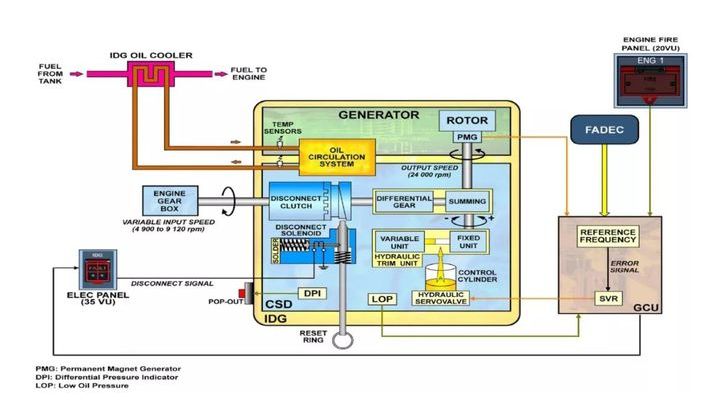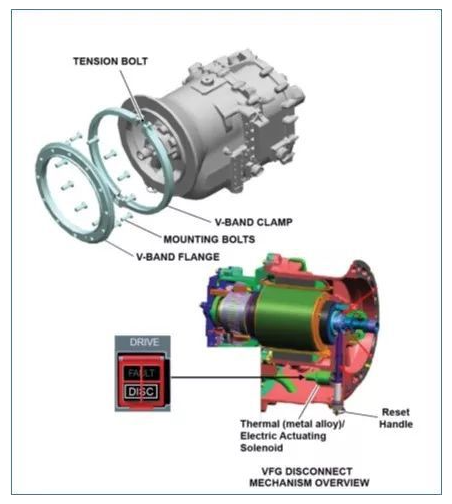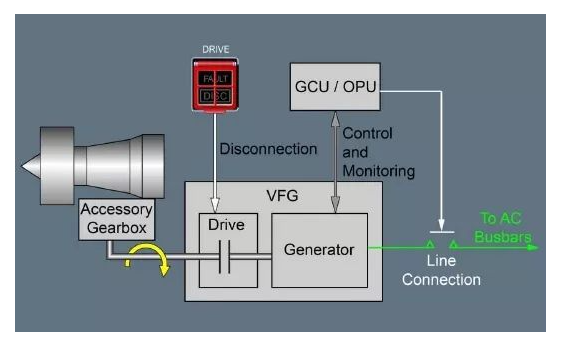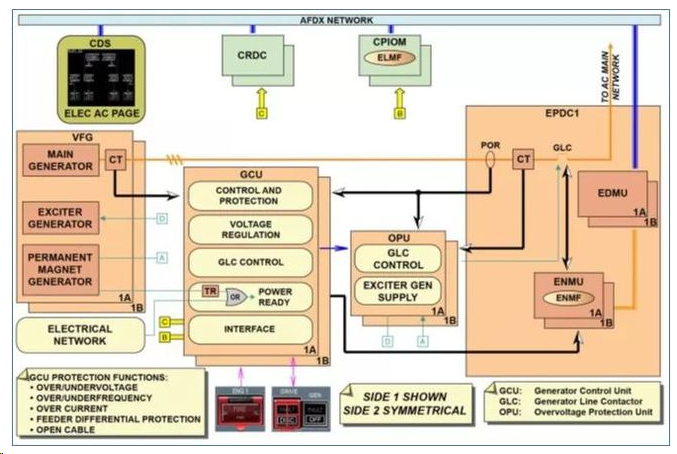This article introduces in detail the basic overview and development history of these four aircraft power systems, analyzes their characteristics in combination with representative models, and discusses and compares their advantages and disadvantages.
There are four types of main power supply systems for modern aircraft:
1. 28V low voltage DC power supply,
2. 270V high voltage DC power supply,
3. 400Hz 115/200V constant frequency AC power supply
4. 360-800Hz 115/200V variable frequency AC power supply.
Low Voltage DC Power Supply (LVDC)
Since the first use of aviation DC generators on aircraft in 1914, aircraft DC power supply systems have undergone a ninety-year development process. Its rated voltage has gradually developed from 6V and 12V to a 28V low-voltage DC power supply system, which has been used to this day.
Advantages:
The 28V low-voltage DC power supply system is simple and reliable.
Disadvantages:
First, the operating speed of brushed DC generators is limited (generally 4000-9000r/min or 7000-13000r/min), and the maximum power of the motor is limited. Its reliable working height is also limited (generally 0-18000m), its working life is also short, and it is inconvenient to use and maintain. Second, the voltage is low, and the weight of the transmission and distribution lines is large at high power.
In the late World War II, 110V DC power supply was used on some large aircraft, but it was not further developed due to the difficulty of high-altitude commutation of motors and the difficulty of high-altitude arc breaking of switch contacts.
Constant speed constant frequency AC power supply (CSCF)
In 1946, the United States invented a mechanical hydraulic constant speed transmission device. It converted the engine's variable speed into a constant speed and then drove the AC generator, which could generate 400Hz 115/200V AC power. This is the aircraft constant speed constant frequency AC power supply (CSCF). The maximum rated capacity of the constant frequency AC generator has reached 150kVA, which is nearly an order of magnitude larger than the DC motor. At the same time, AC switching devices are easy to break arcs, and AC voltage conversion and AC to DC are also convenient. Therefore, over the past few decades, constant speed constant frequency AC power has been rapidly developed and applied.
In the 1970s, Sanderstron successfully combined the constant speed transmission device (CSD) device with the generator in the same housing, sharing the oil source, oil tank and radiator, which was called the integrated drive generator (IDG). Due to the adoption of integral design and oil-spray cooling technology, the motor uses iron-cobalt-vanadium magnetic materials with high saturation magnetic density and improved insulation, which increases the motor speed to 12,000 r/min to 24,000 r/min. The power-to-weight ratio and reliability of the CSCF power supply are greatly improved, as shown in the following figure:

A320/A330 IDG system working principle

The integral drive generator consists of a constant speed device (CSD) and an alternator, mounted together in a housing. The CSD section changes the variable input speed to a constant output speed.
The CSD increases or decreases the input speed from the engine gearbox through a hydro-mechanical drive. The alternator requirement is met by performing this control and constant speed differential. The oil circulation system provides cooling and lubrication for the IDG
The GCU performs control of the IDG output speed through a servo control loop whenever the following conditions occur:
The servo control loop consists of the IDG hydraulic servo valve and the GCU control circuit including the servo valve relay. The output speed control is performed based on the GCU control circuit monitoring the frequency of the PMG. The PMG is mounted on the IDG differential output gear. The frequency signal of the PMG is compared with the frequency reference value inside the GCU.
The difference between the PMG frequency and the reference frequency generates an error signal to the servo control loop circuit. The frequency error signal is used to control the current flow of the servo valve through the servo relay.
The servo valve works by directing lubricating oil into different hydraulic control chambers to control the position of the hydraulic components. Using the error signal, the servo valve controls the amount of oil entering the chamber to maintain the frequency of the generator. When the IDG speed decreases below the reference frequency set point, the servo valve supply increases, increasing the output speed of the IDG.
Under normal circumstances, the servo valve relay is closed, allowing the servo valve to control the flow control of the loop. In the case of a channel failure, the servo valve relay is disconnected, ensuring that the GCU is disconnected and the servo valve operates in the current position.
The FADEC provides engine speed information related to the GCU for low speed protection.
Advantages:
Compared with the system where the constant speed drive and generator are used separately, the combined drive generator is smaller and lighter.
Disadvantages:
The CSD is a precision hydraulic machine that is not only difficult to manufacture, but also inconvenient to use and maintain.
Variable Speed Constant Frequency AC Power Supply (VSCF)
With the development of power electronics, variable speed constant frequency AC power supplies (VSCF) were born and installed in the 1970s. The variable speed constant frequency power supply is generated by the generator directly driven by the aircraft engine to generate variable frequency AC power, which is converted into 400Hz 115/200V AC power through the power electronic converter, as shown in the following figure:

After the 1980s, the VSCF power supply developed by Sundstrand Company of the United States for B737-400 has a rated output power of 60kVA, a brushless DC generator of 65kW, and a high-speed oil-cooled motor with a speed of 13700-25500r/min. The rotor structure has high strength, and its rotation resistance and mechanical stress of the rotating rectifier tube are greatly reduced. The weight of this motor is about 30% smaller than that of the CSCF power supply generator with the same capacity of 12000r/min.
Advantages:
High power conversion rate, the efficiency of constant speed and constant frequency power supply is 68-72%, and that of variable speed and constant frequency is 80%; variable speed and constant frequency power quality is high, and there is no frequency transient process; the installation position of the power electronic converter is flexible, and the self-test circuit can be set, which is easy to maintain; the variable speed and constant frequency power supply can realize starting and generating electricity, eliminating the need for a special starter.
Disadvantages:
Due to power electronic devices, its overload capacity and environmental adaptability are not as strong as the constant speed and constant frequency power supply. This technology has not been able to meet the expected reliability requirements, and is no longer considered a replacement technology for constant frequency power supplies in the field of civil aircraft in the near future.
Variable frequency AC power supply (VSVF)
Since the beginning of the 21st century, A380 and B787 have adopted variable frequency AC power supplies, that is, 360-800Hz 115/200V variable frequency AC power supplies, which has attracted people's attention. The biggest advantage of variable frequency AC power supply is that it eliminates the constant speed transmission device or power electronic converter of the constant frequency AC power supply, significantly simplifies the main power supply of the aircraft, and increases the efficiency of the main power supply to about 90%.

Since the auxiliary power unit generator, ram air turbine emergency generator, transformer, transformer rectifier and other auxiliary emergency power supplies and secondary power supplies on the aircraft can still use constant frequency power supplies, the aircraft power distribution components such as fuses, fuses, switches, relays, contactors, electrical connectors and aircraft wires are the same as the constant frequency power distribution system, which greatly reduces the risk and cost of variable frequency AC power development. The development of variable frequency AC power mainly depends on breakthroughs in motor technology and power conversion technology.
Working principle of A380/A350 VFG system

Each Generator Control Unit (GCU) and Overvoltage Protection Unit (OPU) manages the regulation and protection of its associated VFG. Voltage regulation is done by adjusting the current supplied to the excited generator, based on the current and voltage values detected by the CT and POR. When the electrical parameters are correct, the GCU commands the OPU to close the Generator Line Contactor (GLC). The GCU sends a power-ready signal to the ENMF (hosted in the ENMU), which sends a ground/disconnect signal to the GLC. The GCU (through the OPU) has full authority over the GLC. DRIVE P/BSW is used for mechanical disconnection of the VFG.

The AC generator is directly driven by the engine accessory transmission case, without a constant speed transmission device (used in constant speed constant frequency system) and a secondary conversion device (used in variable speed constant frequency system).
Advantages:
Simple structure, light weight, small size, high power density, high reliability, low cost, high energy conversion efficiency, easy to form a starting power generation system.
Disadvantages:
The frequency variation range is large, and it is difficult to meet the power supply quality requirements of airborne electronic equipment. In order to meet the needs of various electrical loads of the aircraft, there are many secondary power supply conversion forms, and the aircraft power distribution system is very complicated.
High Voltage Direct Current Power Supply (HVDC)
In the past few decades, aircraft electrical equipment has undergone important changes, the main feature of which is the change from linear load to nonlinear load. The internal power supply of most avionics equipment has been changed from linear power supply to switching power supply. The input of the switching power supply is a rectifier circuit with capacitor filtering. It has precise output voltage regulation and becomes a constant power load. Most of the electro-hydraulic and electromechanical actuators used in aircraft control and engine control are combinations of power electronic converters and motors. They are qualitatively different from pumps and fans driven by asynchronous motors and are also nonlinear loads. In the past, most aircraft lighting was incandescent lamps, which were typical resistive loads, but now light-emitting diodes and high-intensity gas discharge lamps must also be combined with power electronic converters to become nonlinear components. At the same time, the large-scale application of computers and the relaxation of the static stability of military aircraft flight control systems require uninterrupted power supply. At present, even the aircraft constant frequency power supply can only achieve uninterrupted conversion, which is far from meeting the uninterrupted power supply requirements. In this case, high-voltage direct current power supply (HVDC) has once again attracted people's attention.
The fourth-generation fighter F-22 tested by the United States in 1997 was the first aircraft equipped with a 270V high-voltage direct current power supply. The main power supply is two 65kW, 270V DC generators, the auxiliary power supply is a 22kW, 270V DC generator driven by an auxiliary power unit (APU), and four 270V/28V, 2.1kW DC converters and two 6kVA static converters are secondary power supplies.
The successful application of 270V high-voltage DC power supply mainly depends on three technological breakthroughs:
a. The birth of brushless DC generators and motors;
b. The development of contactless solid-state electrical appliances, often called solid-state power controllers;
c. Modularization and miniaturization of power converters.
High-voltage DC power supply is as simple and reliable as 28V low-voltage DC power supply, and is suitable for non-linear loads. At the beginning of the 21st century, the F-35 fighter jet tested by the United States not only used high-voltage DC power supply, but also was the first multi-electric military aircraft. The main power supply of this single-engine fighter is a 250kW switched reluctance starter/generator, which is directly driven by the aircraft engine. The power converter of this motor is a 125kW dual-pass reverse structure, as shown below:

Since there are no magnetic steel and excitation coils on the rotor of the switched reluctance motor, it has high reliability. The two independent power converters are redundant, which significantly improves the reliability of the power supply. The characteristic of the more electric aircraft (MEA) is that electric energy replaces centralized hydraulic and pneumatic energy, thereby improving the reliability and maintainability of the aircraft and reducing the weight and full-cycle cost of airborne equipment. The increased power of the main power supply is mainly used to supply power to the electro-hydraulic and electromechanical actuators for aircraft and engine control, the electric fuel supply system, the aircraft environmental control system, and the aircraft door and landing gear control mechanism.
Future development trend
In summary, in the context of the rise of more electric aircraft, variable frequency AC power supply or AC and DC hybrid power supply system will be more widely used and developed in the field of large civil aircraft; and the 270V high-voltage DC power supply system is highly favored in the field of military light aircraft and is a hot spot and focus of current research and development. The high speed, integration, high reliability and high power density of aircraft starting/generating systems are also bound to be the development trend of modern aircraft power systems.
References:
"Modern Aircraft Power System and Its Development" (Wan Weiyue, Yan Yangguang)
"Current Status and Development of Power System for Large Civil Aircraft" (Cheng Guohua)
"A320/A350 TECHNICAL TRAINING MANUAL"
Notice: The article comes from the Internet.









